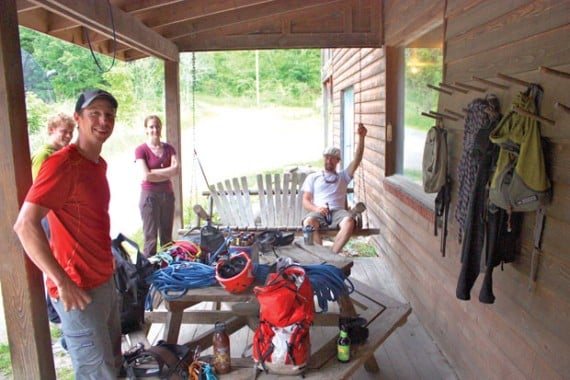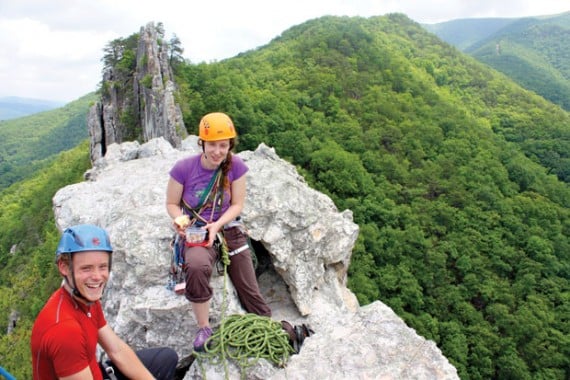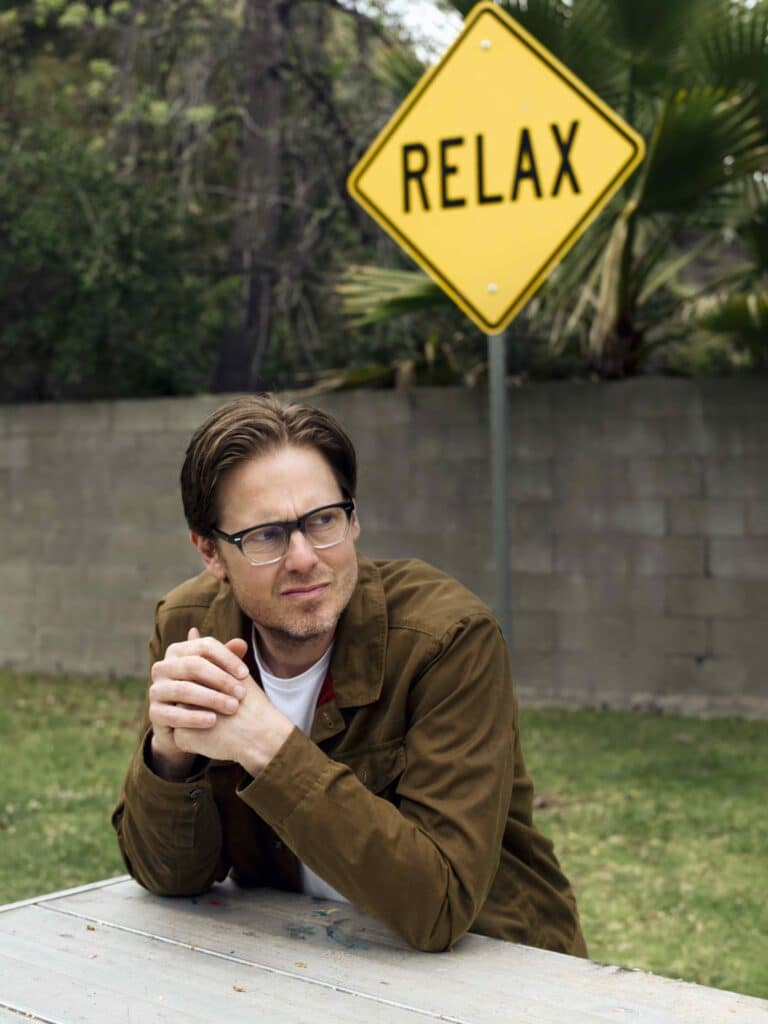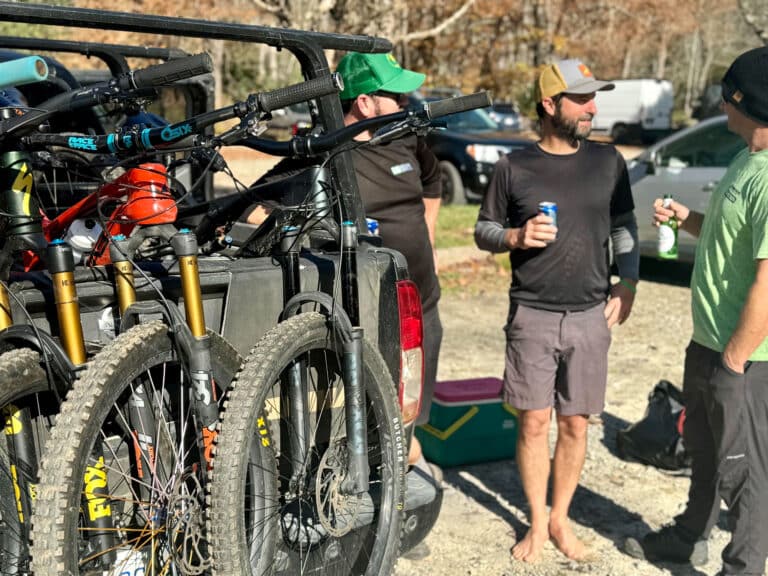A rookie rock climber gets schooled at Seneca Rocks.
There’s a green ammunition can tucked into a crevice at the top of a mountain in West Virginia. Open it and you’ll find a log book, where climbers write things like “AMAZING” in all-caps. There’s also a warm bottle of beer, some sunscreen, a condom, a matchbox car. If you want to write a note in the log book or leave something cool, like an action figure, you have to climb the South Peak of Seneca Rocks, a fin of rock that rises 900 feet from a ridge inside the Monongahela National Forest. It’s not an impossible task—there are much harder climbs in the South, but nothing with the same sense of character. The South Peak is the only mountain east of the Mississippi that you can only summit via a technical rock climb. The only way up is sheer, vertical rock that hangs over the North Fork River valley. The exposure from South Peak can induce vertigo instantly, and yet, thanks to the diversity of mild routes and professionalism at Seneca Rocks Climbing School, there is no better place for a would-be climber to learn multi-pitch traditional skills in the South. You just have to work up the nerve to climb.
Seneca Rocks is intimidating even from the valley floor. The crag has a Western look to it, with two big walls of gray sandstone reaching into the thin, misty clouds most mornings. A trail leads to the top of the North Peak of Seneca, but a deep notch separates the North Peak from the South Peak. The cliff is so unlike anything else you’ll see in the Southern Appalachians, it looks cartoonish—like the kind of mountain peaks Dr. Seuss might have drawn. Distinct knobs and arêtes give the cliff a jagged, fin-like appearance.
“What that is, is the exposed back of a monster. When the real end of the world comes, that monster is going to rise up so big, it’ll make a Cracken look like an ant.”
This is Bob, a recently retired UPS driver who’s been climbing Seneca for more than 30 years. I’ve just met Bob, but in less than four minutes, he’s convinced me that climbing Seneca is one of the few things a man can truly be proud of. He’s also convinced me I’m completely out of my league.
We’re sitting at opposing tables on the front porch of the only restaurant in unincorporated Seneca Rocks, an outpost with half a dozen buildings at a crossroads inside the Monongahela National Forest.
Bob is three beers into the night and keeps telling me things like, “Seneca is so steep, it doesn’t even get wet when it rains,” and “there are 5.2s on Seneca that make me nervous.”
There’s some truth to this last statement. Most climbers agree that the majority of routes at Seneca have sandbagged grades, so a 5.4 at Seneca might be rated a 5.7 somewhere else. Seneca is so old, a majority of the easier routes on this cliff were established in the early ‘40s, when 5.10 was the hardest conceivable route. The 5.2 grade given to Old Man’s route, a four-pitch route that traverses the west face of South Peak to the summit, had more weight.
“I climb 5.12 in the gym, but I get sketched out on some 5.4’s at Seneca,” says Jimmy, Bob’s climbing partner.
Awesome.
But this is why Seneca Rocks Climbing School exists: to translate the myth of Seneca and churn out legitimate rock climbers. Like thousands before me, I’ve signed up for the school’s “Gym to Crag” course, a two-day intensive camp designed to take climbers with decent movement skills and turn them into competent, thoughtful trad climbers.

J.LO’S NOSE
Seneca Rocks Climbing School is located in a small, one-story building attached to the back of the Gendarme, Seneca’s oldest climbing shop. The two businesses are owned by the same family and run by the same handful of young guides. The school has set the standard for climbing instruction on the East Coast for more than 35 years. During the ‘70s, the shop and school were operated out of the back of a Volkswagen bus, so the humble retail and teaching space seem downright spacious considering.
Massey Teel is the head instructor and guide. He’s barely 30 and has the wiry build of a runner. He’s been with Seneca for six seasons, but grew up on a 300-acre family farm near Charlottesville, Va. and still goes home to tinker with projects like growing hops. During the fall, he guides trips in Red Rocks, Nevada. In the Winter, he runs the adaptive skiing program at Virginia’s Wintergreen Resort. He is a rarity in the South: a professional guide.
“If I could guide until I’m 50, I’d be happy,” he tells me during our approach to the crag on the first day of the course. He’s using the term “guide” loosely. He’s more of an instructor than a guide.
“If someone just wants us to guide them up the summit, we’ll do it,” Teel says. “But I’d rather spend my time teaching that person how to really climb.”
There’s plenty of action in the Gym to Crag course, but the two days are also loaded with materials lessons, mock multi-pitch scenarios, anchor-building pop quizzes, and knot-tying homework.
We hump our way up the Stair Master, a series of boulder steps that rise from Seneca Creek to base of the South Peak. Teel carries 35 pounds of trad gear in his oversized pack and lets me get away with just a few carabiners and the rope.
We drop our gear on the Luncheon Ledge, a six-foot-wide belay station at the base of some easy top-rope climbs. This is the school’s choice location for “Ground School.” Two other guides are there, working students through the same Gym to Crag curriculum. A father and two teenage sons are busy learning the terminology and gear associated with traditional climbing.
Most beginners start in a gym, then dabble with top-roping with climber friends. It’s a fine pastime, but if you want to climb well in the Southern Appalachians, you have to learn the art of traditional climbing, where the lead climber sets temporary protection in cracks along the route, and the second climber cleans the protection from the rock. The climbing team moves up the wall, pitch after pitch, taking turns belaying and climbing. It is a symbiotic relationship unlike any other in the sport. Every decision the lead makes directly affects the second, and vice versa.
Teel explains the subtleties in the necklace of nuts, caribiners, and spring-loaded cams that he organizes meticulously on his harness. The lesson? Presentation is everything. How you organize your gear, how you coil a rope–it shows other climbers that you know what you’re doing and can be trusted.
I fumble with the little things, like taking carabiners off the gear loops of my harness. Tying the standard figure eight knot is like a puzzle I can’t solve.
There are half-a-dozen climbers on the South Peak, spread out between 150 routes. On a busy weekend, you might wait in line to knock out some of the more popular climbs, but Seneca doesn’t see the mass of climbers it saw during its heyday.
In the early ‘90s, Seneca Rocks was one of the hottest climbing destinations in the East. Superstars put up hard routes until there wasn’t room for further development. So they moved to the New River Gorge in the late 90s. When a bolting ban constricted route setting in the New, they moved to the Red River Gorge, in Kentucky. Seneca is still well respected, but no longer enjoys the “it crag” status.
If you look at Seneca on paper, it can’t compare with crags like the New River Gorge. Seneca has 350 routes. The New has 2,000 and counting. But the New is dominated by single pitch routes, whereas Seneca is fraught with long, multi-pitch climbs that rise hundreds of feet. There are taller cliffs, like the 1,200-foot granite face of Laurel Knob in North Carolina, but the granite in North Carolina tends to slope, so you can only see one pitch below you. Not so, in Seneca.
“As far as exposure, Seneca kills it in the East. There’s nothing with this sort of explore,” Teel tells me as we scramble around the edge of the South Peak to the east face of the wall. “It has these incredible arêtes with a lot of air below.”
Lizards scatter as we move across the rocks, scrambling to the east face of the South Peak. You can hear cicadas tearing up the valley below us, sending loud, repetitive screeches through the mountains and gaps.
We climb the three pitch Up and Coming (5.4), which has a couple of sketchy stem moves for the crux on the first pitch. I like having to clean the gear as I move up the rock. It gives me something to think about other than the fact that I’m 600 feet above the ground.
The third pitch leads us up Humphrey’s Head, a singular arête along the lower ridge of the South Peak. Climbers call the last pitch “picking the nose,” because if you’re watching from the valley, it looks like the climber is ascending into Humphrey’s nose.
Teel says the profile of the rock we’re climbing looks like J Lo from the valley floor.
Standing on top of Humphrey’s Head, we look down on turkey vultures circling near the cliffs below us.
Day one ends with homework: I fall asleep in my tent working on my knots with a piece of practice rope.
THE SOUTH PEAK CAMPAIGN
“The higher we go, the more loose rock we’ll encounter,” Teel tells me as we climb the Stair Master on the morning of day two. He’s describing the four-pitch climb we’ll take up the west face to the summit. “Always remember this is a cliff. And big things fall off of cliffs.”
We start on Prune (5.5), with a tough laid back move up a wide crack. It’s physically demanding, but low enough to the ground that it’s not psychologically troubling. After Prune, we traverse a short ledge to Front C (5.6), the toughest pitch of the day. The heart of the route follows a crack in the corner of the wall for 30 feet. At the crux, you have to set your feet wide, spanning the width of the corner, while you jam your hands into the ever-widening crack for purchase. At one point, I have to stick my whole left forearm into the crack and squeeze, pulling my body up to the next foothold.
The final pitch, Le Gourmet (5.4), is up a chimney that gets thinner until it delivers you onto an arête that you follow into thin air just short of the summit. The moves are simple, but the exposure is mind-numbing. From the top of Le Gourmet, Teel wraps the rope around his own waist to create a simple body belay as I down-climb a cliff to the narrow South Ridge, then we scramble along bright white quartzite to the true summit, where the ammo can waits.
From the top, you can see the razor-thin fin of rock running to the north and south. The valley rolls away below us before rising into dark green mountains in all directions. In 1939, it took the first group of climbers two full days of climbing to stand on top of Seneca Rocks. It was a legitimate summit campaign. It still is.
“Seneca is a mini-alpine environment where you can learn all these great summit-specific skills–down climbing, scrambling, body belaying–that you can apply in bigger environments,” Teel says. And you don’t have to be a superstar to enjoy it. “You can come up here, climb a 5.2, and have a true alpine adventure.”
web extra!
Learn how to open a beer with a carabiner from Seneca Rocks Climbing School.
Ever wonder which Colleges are the most outdoorsy along the East Coast? We did too so we made a guide!







